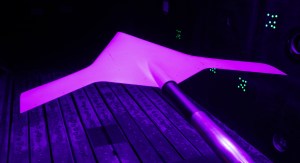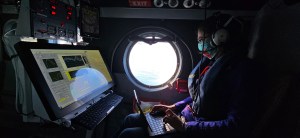Before NASA’s next lunar rover paves the way for long-term human exploration of the Moon, it must first pass a series of rigorous mobility tests along the banks of Lake Erie.
The Simulated Lunar Operations Laboratory, or SLOPE Lab, at NASA’s Glenn Research Center in Cleveland is home to multiple sandboxes that mimic the lunar and Martian terrain to evaluate the traction performance and limitations of current rover designs. As rovers become more sophisticated and complex, the team at SLOPE is adding unique capabilities to help simulate terrain conditions and test rover performance prior to launch.
Recently, the team at Glenn used a test version of NASA’s Volatiles Investigating Polar Exploration Rover, or VIPER, to evaluate and fine-tune a newly installed OptiTrack motion tracking camera system. This extremely accurate set of 16 motion tracking cameras looks for infrared light produced by LEDs inside small white balls, called markers, installed across the lab and on the test vehicles.
This allows engineers to precisely measure real-time movement and compare it to existing computer models to determine if the vehicle is performing as expected. It also creates detailed, 3D animations as a rover travels across the simulated terrain, which are critical to engineering teams during testing and to inform future rover designs.
“The OptiTrack gives us the ability to track large and small vehicles and produce excellent data with a very high level of accuracy, down to around one millimeter,” said Erin Rezich, lead test engineer at the SLOPE Lab. “Whether on the Moon or Mars, a rover’s path holds a lot of unknowns, so the more testing and the higher quality data we can produce, the better understanding we’ll have in terms of vehicle performance.”
With the new SLOPE systems now installed and verified, the team is ready for the newer, higher fidelity VIPER engineering model to arrive this fall for final mobility testing. This final evaluation will collect data to be used in the rover’s pre-launch reviews before it catches a ride to the Moon in late 2023 under NASA’s Commercial Lunar Payload Services initiative.
VIPER is helping further the agency’s Artemis program because it is humanity’s first opportunity to robotically explore and map the presence of water ice on the lunar surface.
“Having never sent a rover to the lunar South Pole, we must be ready for harsh, relatively unknown conditions,” said Yajaira Sierra-Sastre, project manager for VIPER testing at NASA Glenn. “SLOPE now provides several unique capabilities to help us understand mobility performance demands to ensure VIPER will be successful from the moment it first rolls off the lander.”
Jimi Russell
NASA’s Glenn Research Center
































